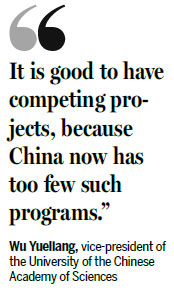Ground infrastructure construction on China's gravitational wave research project, Tianqin, began on Sunday in Zhuhai, Guangdong province.
At an estimated cost of 10-20 billion yuan ($1.5-3 billion), the project plans four steps during the coming two decades to launch three satellites into high Earth orbit and detect gravitational waves.
The first step includes the construction of a 30,000-square-meter research building, a 10,000-sq-m ultraquiet cave laboratory and a 5,000-sq-m observation station on the Zhuhai campus of Guangzhou-based Sun Yat-Sen University.
"We will take steps to raise funds for the program because Tianqin is such a big project planned over such long period of time," Li Miao, director of the university's Institute of Astronomy and Space Science, told Beijing Youth Daily.
That report said the city government of Zhuhai will invest 300 million yuan in the project to get it going.
"Given the overall investment scale, the project will seek various sources of funds for each of its different parts, including financing from local governments and private companies," Li said.

On Feb 11, scientists at the Laser Interferometer Gravitational-Wave Observatory, or Advanced LOGO, in the US confirmed they had directly detected gravitational waves for the first time. That captured the interest of scientists who were engaged in related research worldwide.
A few days later, scientists at the Chinese Academy of Sciences announced that they would propose a space-based detection program by the end of this year that could be part of the European Space Agency's ELISA project.
"We have been cooperating with the European Space Agency since 2009. It has been accumulating theoretical research on this subject for three decades," said Wu Yueliang, vice-president of the University of the Chinese Academy of Sciences. "In this sense, we have an advantage over other gravitational wave research projects in China.
"It is good to have competing projects, because China now has too few such programs."
Predicted by Albert Einstein 100 years ago, gravitational waves are tiny ripples in the fabric of space-time caused by violent astronomical events.
Wu Ji, director of the National Space Science Center at the Chinese Academy of Sciences, was optimistic about funding for such speculative science during the 13th Five Year Plan (2016-20).
"With the initial success of Advanced LOGO, I think Chinese decision-makers are likely to allocate more resources to gravitational wave research in the coming five years," he said.
chengyingqi@chinadaily.com.cn
(China Daily 03/22/2016 page4)
A Frenchman in a coastal Chinese city has combined his zeal for work with passion for life, writes Raymond Zhou.

One of the potentially most traumatic things a girl has to go through is finding a new hairdresser.